Allium Leafminer
go.ncsu.edu/readext?1003008
en Español / em Português
El inglés es el idioma de control de esta página. En la medida en que haya algún conflicto entre la traducción al inglés y la traducción, el inglés prevalece.
Al hacer clic en el enlace de traducción se activa un servicio de traducción gratuito para convertir la página al español. Al igual que con cualquier traducción por Internet, la conversión no es sensible al contexto y puede que no traduzca el texto en su significado original. NC State Extension no garantiza la exactitud del texto traducido. Por favor, tenga en cuenta que algunas aplicaciones y/o servicios pueden no funcionar como se espera cuando se traducen.
Português
Inglês é o idioma de controle desta página. Na medida que haja algum conflito entre o texto original em Inglês e a tradução, o Inglês prevalece.
Ao clicar no link de tradução, um serviço gratuito de tradução será ativado para converter a página para o Português. Como em qualquer tradução pela internet, a conversão não é sensivel ao contexto e pode não ocorrer a tradução para o significado orginal. O serviço de Extensão da Carolina do Norte (NC State Extension) não garante a exatidão do texto traduzido. Por favor, observe que algumas funções ou serviços podem não funcionar como esperado após a tradução.
English
English is the controlling language of this page. To the extent there is any conflict between the English text and the translation, English controls.
Clicking on the translation link activates a free translation service to convert the page to Spanish. As with any Internet translation, the conversion is not context-sensitive and may not translate the text to its original meaning. NC State Extension does not guarantee the accuracy of the translated text. Please note that some applications and/or services may not function as expected when translated.
Collapse ▲Background
This spring some growers in the North Carolina piedmont have noticed unusual problems with their allium crops, primarily bulb onions, leeks, and garlic. Obvious above-ground symptoms include twisted/distorted leaves, stunted plants, and even plant death. Below ground, brown pupae can be found infesting the plants and upon close inspection larvae can be seen feeding inside the leaves and bulbs.
It turns out the culprit is allium leafminer (ALM) which is a new pest in North Carolina. The allium leafminer fly (Phytomyza gymnostoma) is an invasive insect pest from Europe that was first detected in the U.S. in 2015 in Pennsylvania. It has now spread to New York, Massachusetts, Connecticut, New Jersey, Delaware, Maryland, Washington D.C, Virginia, and now North Carolina. The ALM has decimated leek and scallion crops in parts of New York and caused headaches for growers with other crops so it commands our attention.
The allium leafminer was first reported to the NC State University Plant Disease and Insect Clinic (PDIC) last summer. Dr. Matt Bertone is the Director of the PDIC: “I was aware of this pest in the Northeast, but I didn’t know if and when it would get here. Unfortunately in June of 2023 we received two allium samples in the clinic from Orange and Guilford Counties with suspicious larvae and pupae. I was certain these were allium leafminer flies but we couldn’t confirm it at the time based on visual inspection. So we ground up a few larvae and used DNA barcoding to confirm that it was that species.”
I had not encountered the allium leafminer until this spring when reports started coming in at the end of April from growers having allium problems. I visited a few area farms to inspect their allium crops and confirmed the allium leafminer at all of them. I collected samples of different crops and brought them home to inspect thoroughly and photograph larvae, pupae, and other signs. I’ve had a crash course in the allium leafminer over the past few weeks as I read papers and talk and Zoom with Cornell specialists and agents about their experiences and research with the ALM!
We still have much to learn about allium leafminer in North Carolina since it is a new pest and we have a different climate than the northeast. However I wanted to go ahead and share what I have learned so growers can be aware. I will keep this page updated as I learn more. I hope to do a grower survey soon to collect some information from growers to help us help you.
Host Plants & Life Cycle
Allium leafminer infests a broad range of alliums including bulb onions, scallions, leeks, garlic, chives, shallots, ramps, ornamental alliums, and wild alliums (including weeds).
There are two generations each year, in the spring and the fall. In the northeastern U.S., the first generation is active in the spring from March-June. The flies start emerging from overwintered pupae found in crop debris or soil starting in March and continuing for five-six weeks; oviposition (egg-laying) on crops occurs from March-May and larvae develop through several instars before pupating in June. The pupae estivate (remain dormant during a hot/dry period) through the hot summer months and the second generation adults emerge in mid-September and October, with up to eight weeks of oviposition activity (longer than in the spring). Larvae develop and complete pupation in November and December. This timetable is for the northeastern U.S. We do not yet know the exact time of emergence for the first and second generations for the ALM in North Carolina. Most likely the first generation will emerge earlier here since we are warmer. And since this pest estivates during the hot summer to avoid the heat it makes sense that the second generation might emerge later here as warm temperatures persist later into the year.
Crop Damage
Crop damage from the allium leafminer can range from cosmetic to total crop loss depending on the crop and the level of infestation.
The earliest sign of allium leafminer activity (in both the spring and fall generation) is the oviposition marks they create on leaves that indicates adults have emerged and have started laying eggs. In the northeastern U.S., the flies start laying eggs about 10-14 days after emergence.
The oviposition punctures look like white dots and are often arranged in a neat row on the leaf (usually at the tip of the leaf but I have also seen them in the middle of the leaf). Male and female leafminer flies feed on the exudates that emerge from these punctures. Female leafminer flies only lay eggs on a fraction of these oviposition punctures. The larvae hatch from the eggs and feed/mine their way down the leaf between the upper and lower leaf surface towards the base of the plant and into the bulb.
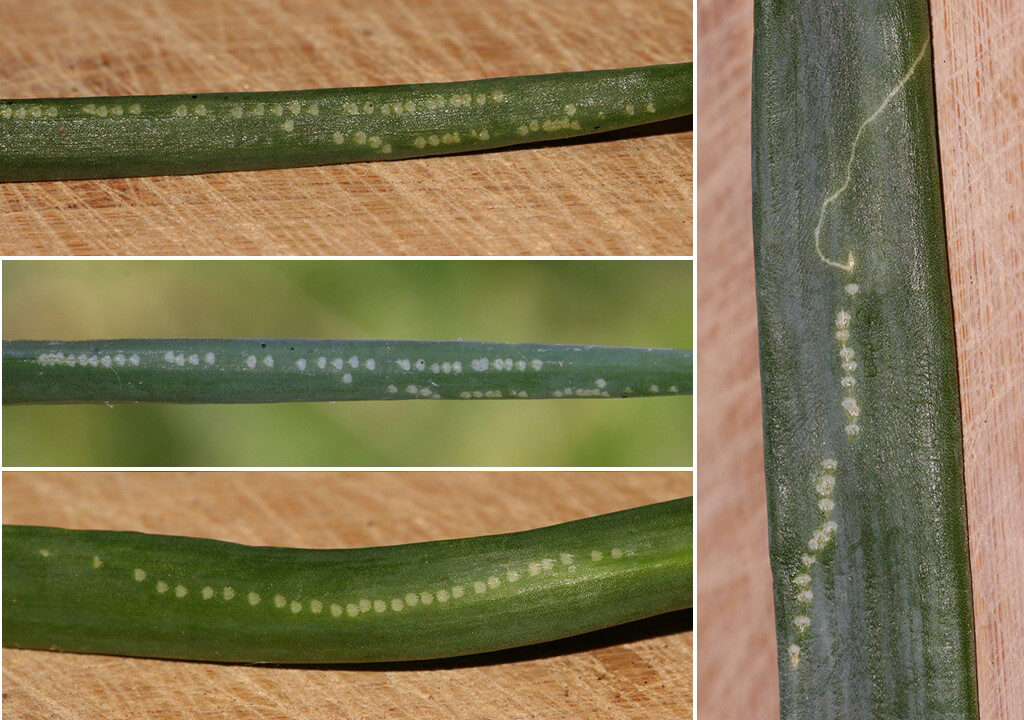
Examples of oviposition marks left on allium leaves. The far right photo also shows mining by an allium leafminer larva. Photos by Debbie Roos.
Larval feeding and mining can cause leaf twisting and distortion and damage to the marketable portion of the crops. Feeding damage can also allow fungal and bacterial pathogens to infect bulbs. Pupae can be captured inside the wrapper leaves of garlic and cause contamination.
In New York, damage from the ALM is higher in the fall (primarily leeks and scallions) than in the spring (highest damage to scallions). They have discovered that ALM is least damaging to direct-seeded onions and shallots because these crops fall between the two ALM generations. New York growers have experienced the most economic losses caused by allium leafminer with fall leeks and fall scallions and some organic growers have stopped growing these crops.

Above-ground signs of an allium leafminer infestation include twisted, distorted leaves as seen here in bulb onions that were planted in late February. Photo by Debbie Roos.

Twisted leaves caused by allium leafminer in red onion. Photo by Debbie Roos.

Same onion pictured above peeled back to reveal allium leafminer larvae feeding in the developing bulb alongside two pupae. Photo by Debbie Roos.
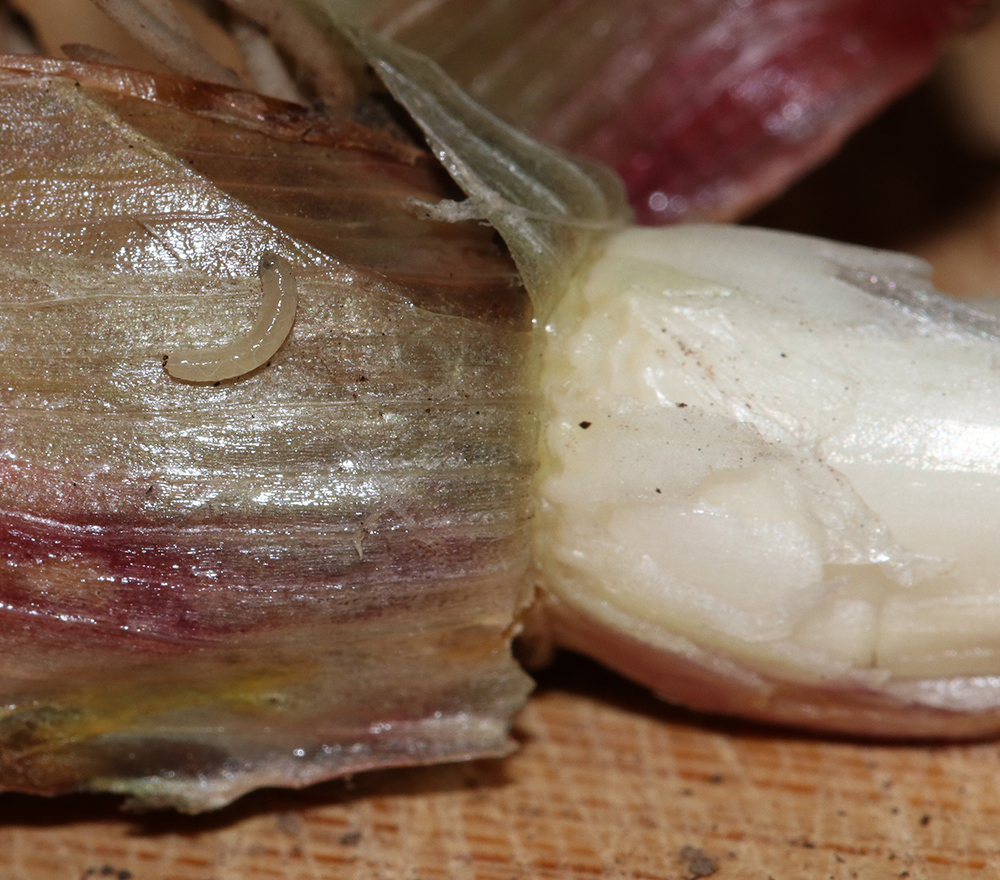
Allium leafminer larva on bulb onion. Photo by Debbie Roos.
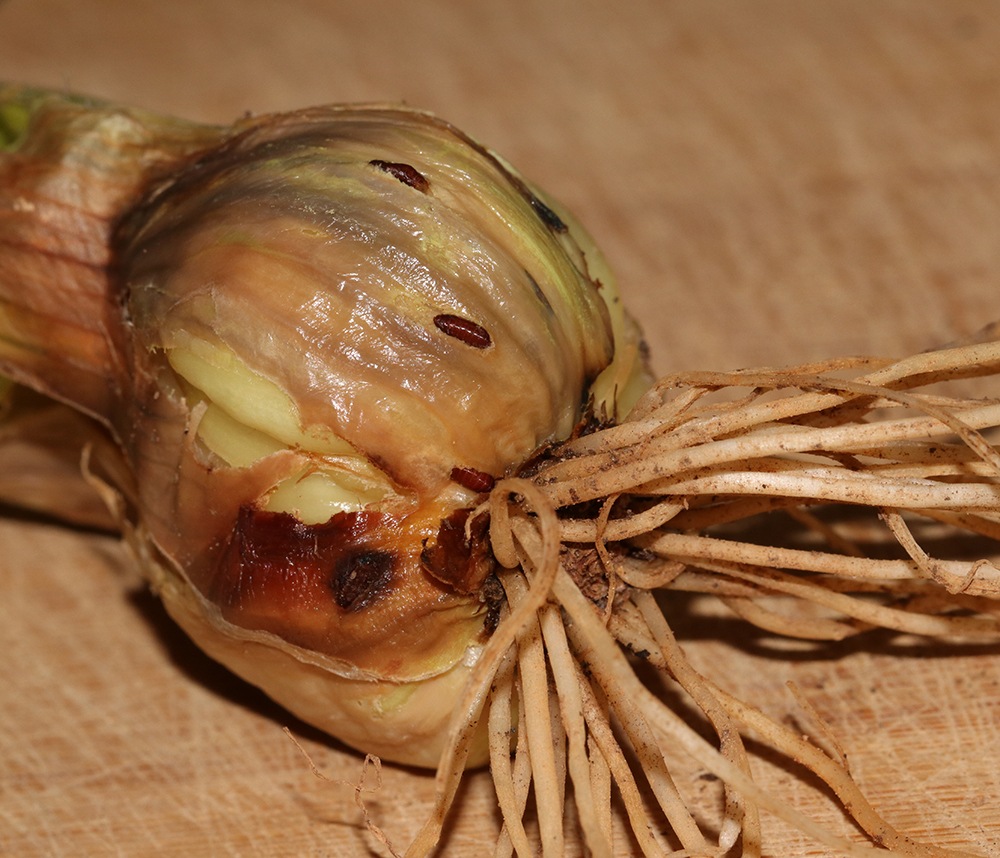
Bulb onion infested with several allium leafminer pupae. Photo by Debbie Roos.
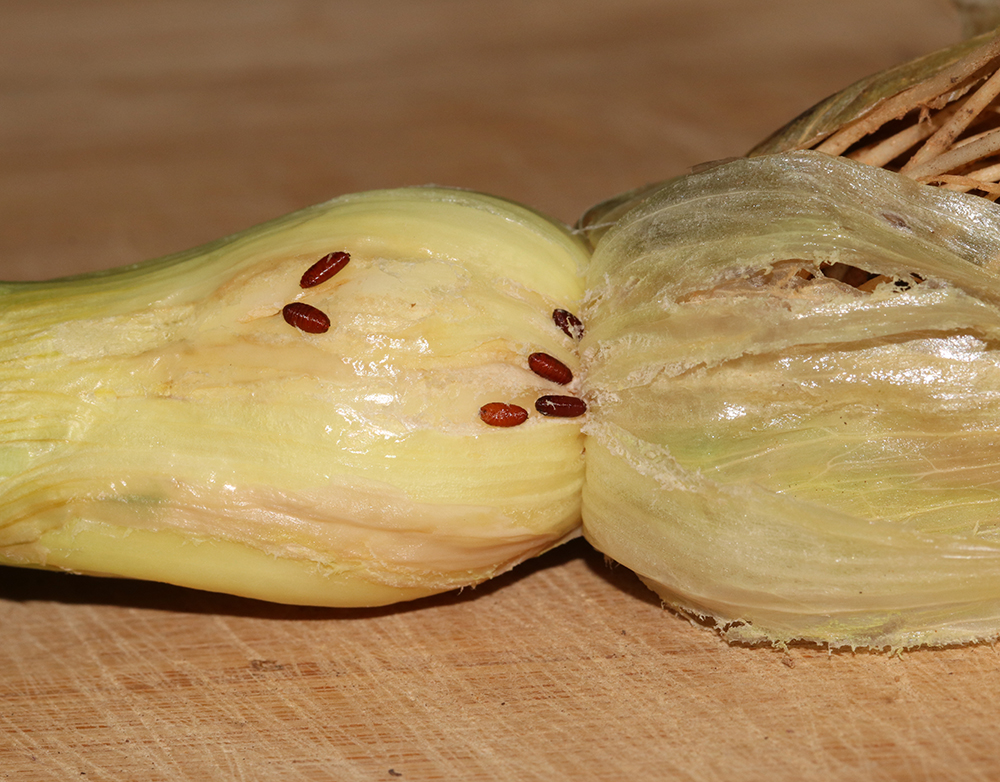
Same onion as above with layers peeled back to better reveal the allium leafminer pupae. Photo by Debbie Roos.
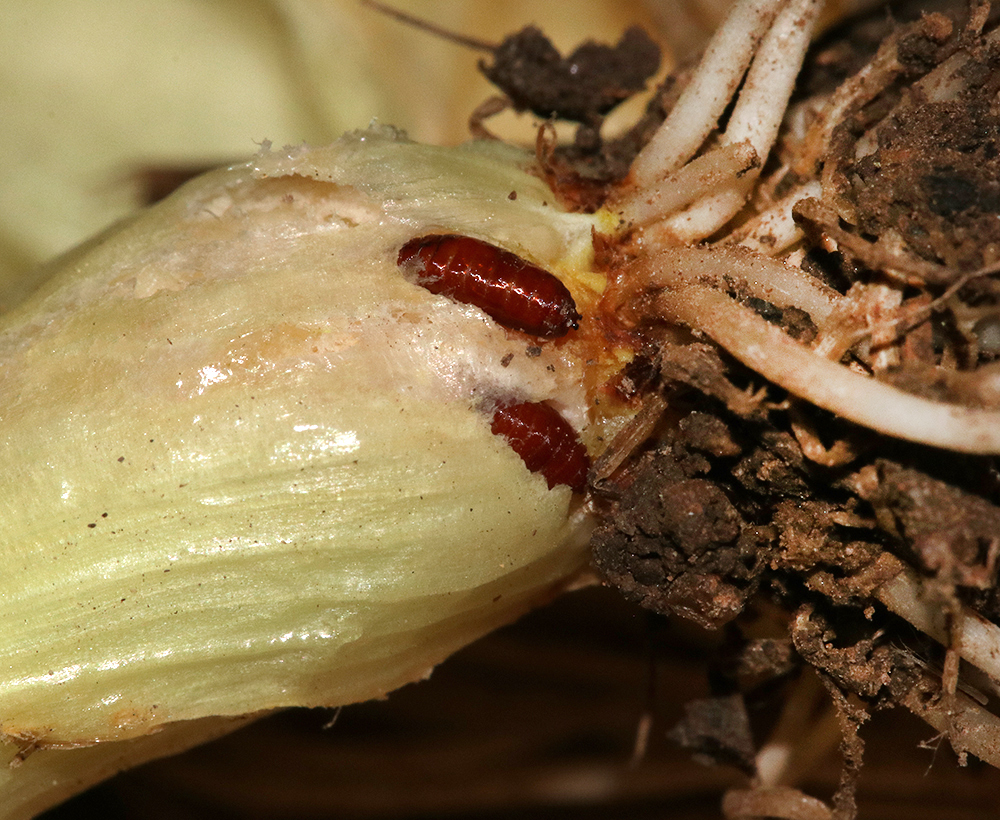
Allium leafminer pupae on bulb onion. Photo by Debbie Roos.

Allium leafminer mining damage on leek. Leeks were planted in mid-February. Photo by Debbie Roos.
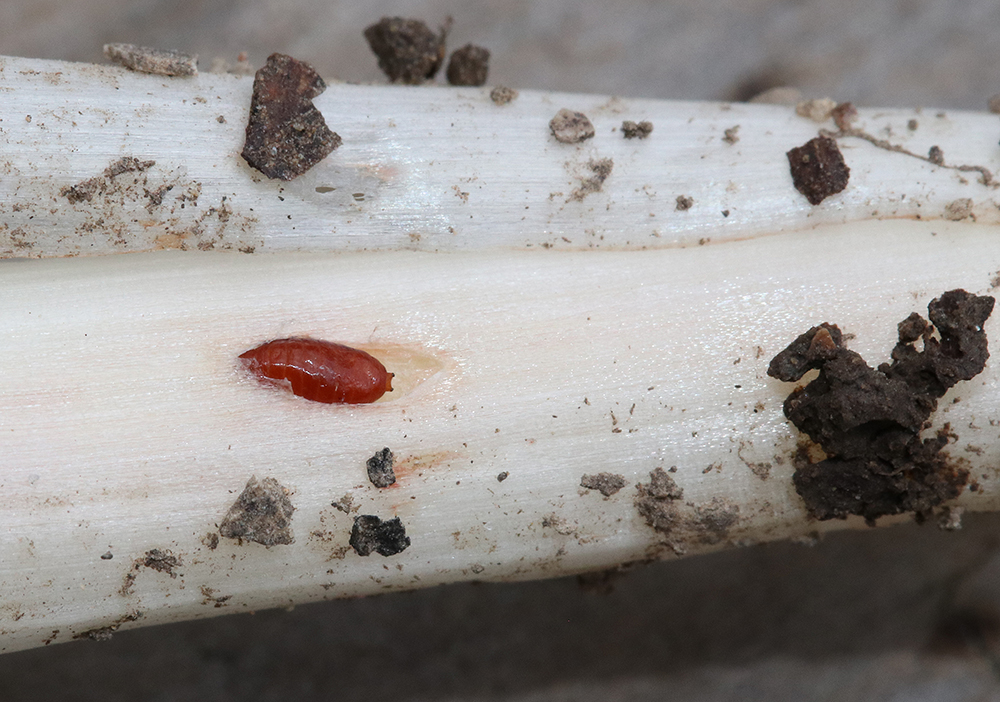
Same leek as in photo above with stem layers peeled back to reveal an allium leafminer pupa inside. Photo by Debbie Roos.

Allium leafminer larva and pupa (lower left corner) on leek. Photo by Debbie Roos.
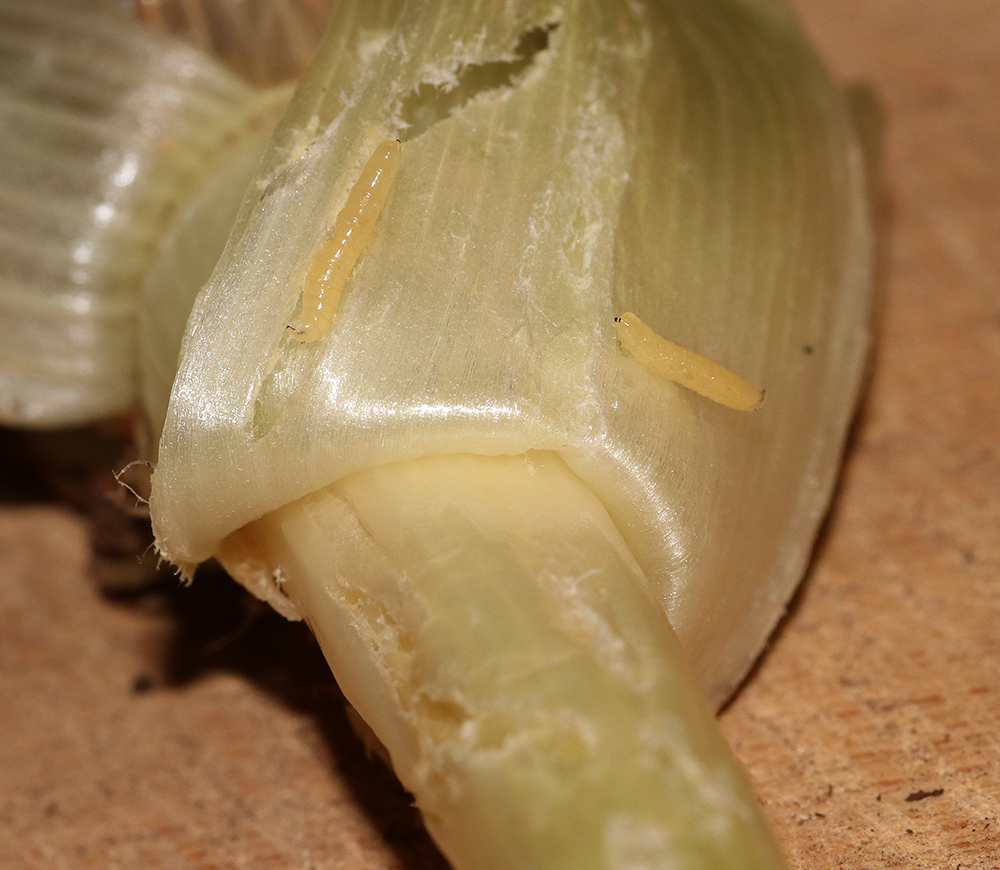
Allium leafminer larvae feeding on leek. Photo by Debbie Roos.

Allium leafminer fly that emerged inside a head of garlic and got trapped and died. Garlic is planted in October and November. Photo by Debbie Roos.

Dead allium leafminer fly found inside a garlic bulb. The allium leafminer fly is only 1/10″ long and has a mostly yellow/orange head. Photo by Debbie Roos.

Allium leafminer pupae inside the wrapper leaves of garlic. Photo by Debbie Roos.
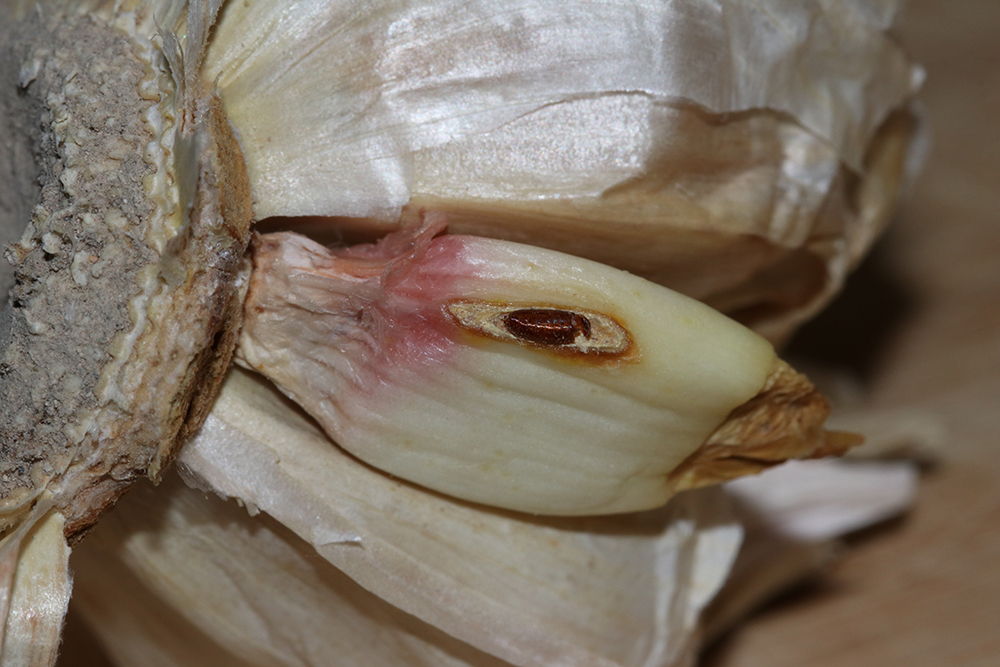
It appears that an allium leafminer larva was feeding on the garlic clove and then pupated right there where it had been feeding. Photo by Debbie Roos.

Feeding damage from allium leafminer on garlic. Photo by Debbie Roos.
Allium Leafminer Management
Since ALM is such a new pest here that means none of us have any experience with it. I need to be able to provide control recommendations for growers so I contacted the author of many of the papers and fact sheets I have been reading out of Cornell: Dr. Brian Nault, Entomology Professor at Cornell University (and it turns out he got his PhD at NC State University!). Dr. Nault was so helpful in answering my questions through phone conversations, email, and Zoom and I am so appreciative of his expertise and willingness to share what they have learned. He also connected me with a couple of their Agriculture Agents who work with allium growers and they have also been very generous and helpful.
ALM Control Strategies:
Crop Rotation
ALM flies are relatively weak fliers so are not capable of traveling long distances. Crop rotation is very important to minimize damage from this pest. Plant allium crops as far away as possible from previous ALM-infested crops or weeds.
Crop Covers
The best strategy is to protect crops during the critical ALM egg-laying period in the spring and fall so crop covers provide the most effective control for ALM. Crop covers could be floating row covers or insect netting and they should be installed before flies emerge. Covers need to be secured to the ground with no gaps so flies cannot enter. The covers need to remain on during the entire egg-laying period. Do not use covers on top of a row that is infested with ALM pupae from a previous season or you will trap the emerging flies under the cover – this is why crop rotation is critical.
Dr. Nault reports that in New York crop covers can provide close to 100% control of ALM. Support hoops should be used when using row covers for leek production to prevent the stems from bending which restricts growth and reduces marketability.
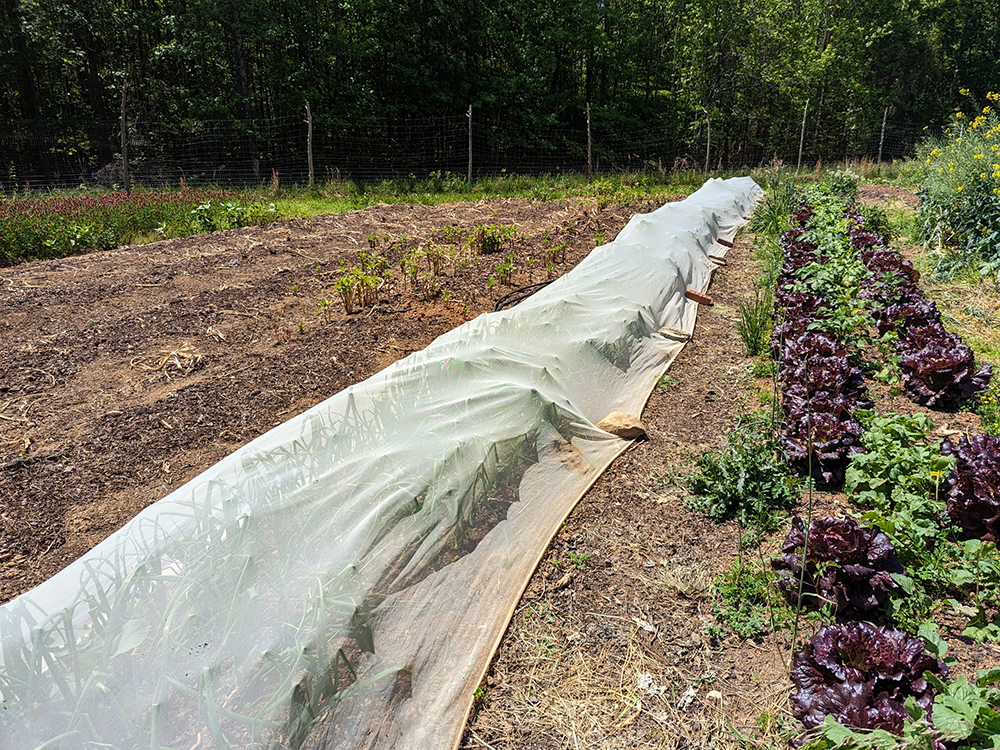
Crop covers are the most effective control for allium leafminer. They must be deployed before egg-laying begins. Photo by Debbie Roos.
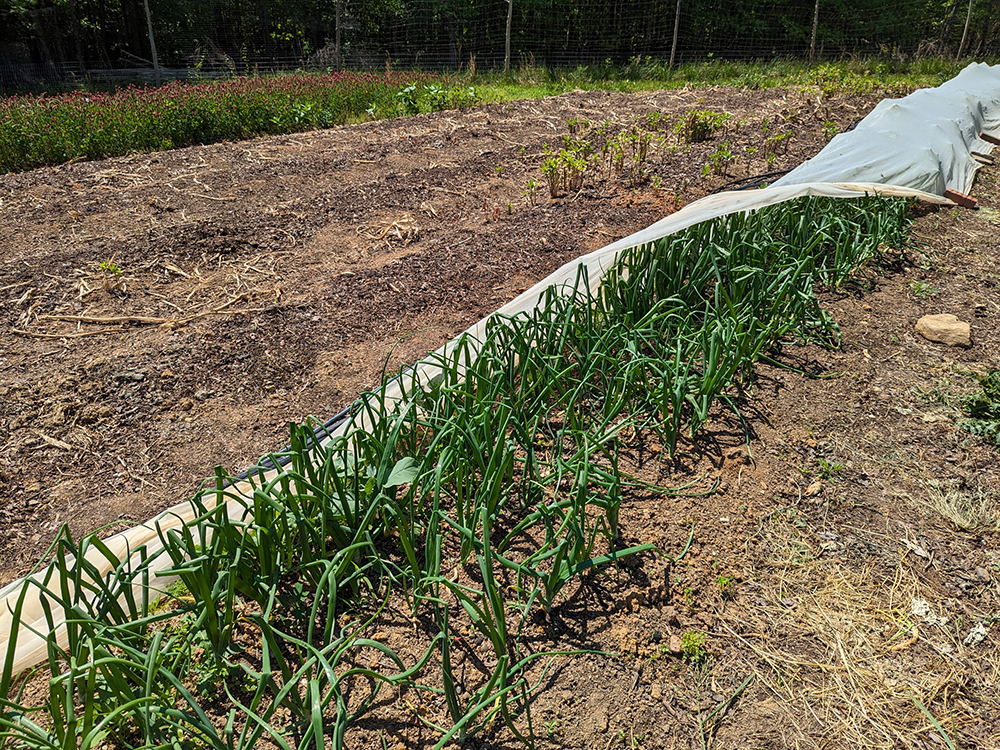
This onion crop had very little damage compared to an uncovered onion bed nearby. Photo by Debbie Roos.
Sanitation
Avoid importing infested plant material onto the farm. Make sure any purchased allium plant material is not imported from states that have ALM. Be careful trading plant material with other growers because you could unknowingly be trading the pest. Cornell Entomologist Dr. Nault believes the primary way that ALM is being spread is by humans through plant material. Many growers trade garlic across states. The nursery industry also needs to be aware of this pest because it also affects ornamental alliums and these plants get shipped around the country and then get planted into landscapes.
Destroy crop debris infested with ALM by burning or deep tillage. Kill any ALM pupae left in the soil through solarization.
Organic Insecticides
Dr. Nault has conducted research at Cornell looking at the effectiveness of the organic insecticide spinosad (Entrust) for ALM control. Entrust SC at 6 fl oz/acre rate is co-applied with M-pede (insecticidal soap – potassium salts of fatty acids) 1-1.5% to help penetrate the waxy cuticle of the allium leaf. His research showed that under low to moderate ALM pressure, two applications of the Entrust + M-pede mixture were effective. The first application is made 2-3 weeks after seeing the first oviposition marks and the second application is made two weeks later. Additional pesticide applications may be needed under high ALM pressure (would need to rotate with something other than spinosad to avoid problems with resistance). Cornell research has shown that it’s important to use M-pede with the Entrust to increase efficacy.
Conventional Insecticides
I reached out to Jim Walgenbach, Professor and Extension Entomology Specialist at NC State University, for conventional pesticide recommendations to control the allium leafminer. “Based on colleagues’ work in New York and Pennsylvania, the following insecticides were most effective in suppressing allium leafminer: dinotefuran (Venom, Scorpion), cyantraniliprole (Coragen), and spinetoram (Radiant). While soil applications of dinotefuran and cyantraniliprole have systemic activity and control many insects when applied in this manner, they did not control allium leafminer, so foliar applications are required,” said Walgenbach.
Scouting
Whether growers plan on using crop covers or organic pesticides, they need to know when the allium leafminer flies emerge in the spring and fall. These two management strategies rely on knowing these dates. Dr. Nault reports that in New York they did not have success using sticky cards for monitoring ALM emergence because the flies were simply more attracted to the crop than to the cards so growers need to be diligent about being in the field 1-2 times per week scouting for oviposition marks early in the season.
I also talked with Cornell Vegetable Specialist Teresa Rusinek who works directly with growers in the Hudson Valley where they have been dealing with the allium leafminer since 2016. Teresa and her colleagues plant allium sentinel plots to help monitor ALM emergence. They have also tracked Growing Degree Days (GDD) for the spring and fall emergence of ALM in the Hudson Valley since 2017. “The GDD model is not perfect but it does help inform us as to when we should start monitoring sentinel plots and trials for ALM emergence,” Rusinek said.
As I mentioned above, we expect to see differences in ALM emergence times between New York and North Carolina. The areas in New York where the allium leafminer are present are in USDA Plant Hardiness Zones 5b, 6a, and 6b. North Carolina’s Plant Hardiness Zones range from 6a-9a (here in Pittsboro we are zone 8a). This fall will present a good opportunity to collect data on emergence times across the state!
For More Information
Allium Leafminer Identification, Biology, and Control – Cornell University


